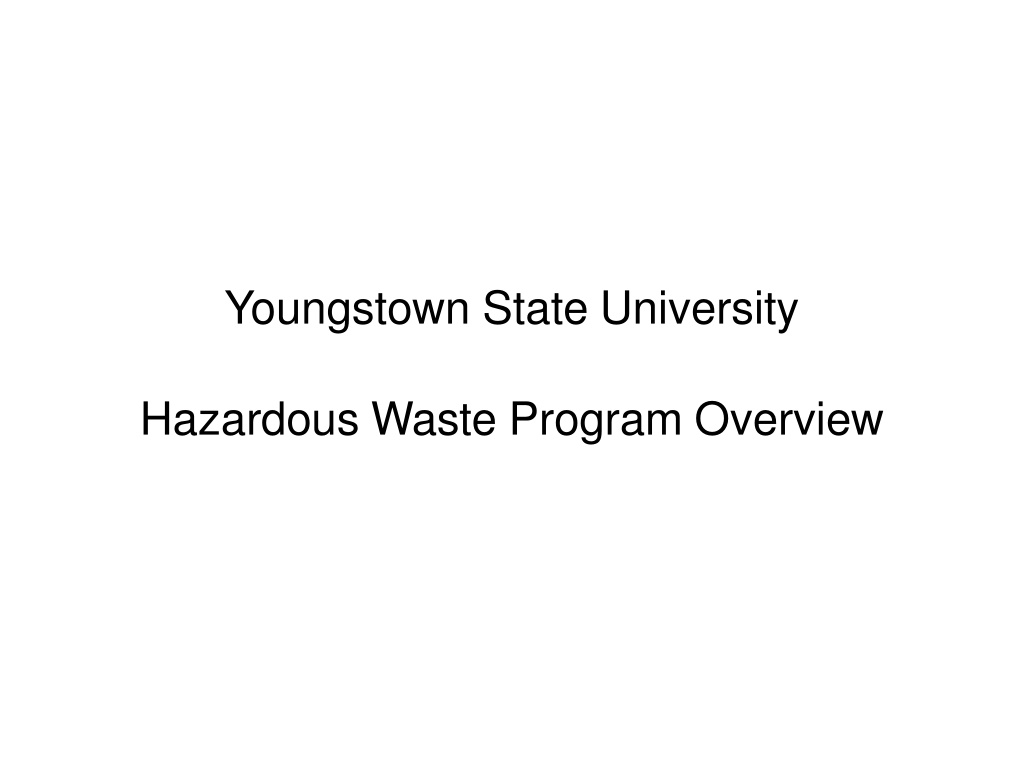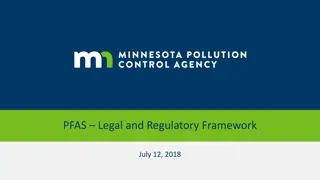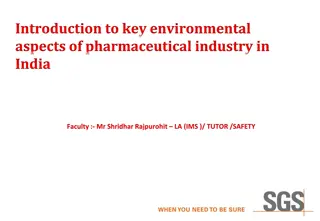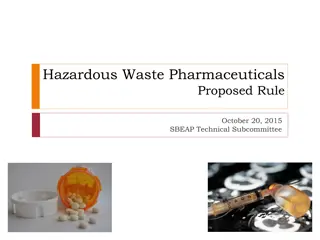Youngstown State University Hazardous Waste Program Overview
The Hazardous Waste Program at Youngstown State University follows a cradle-to-grave approach, encompassing laws, regulations, inspections, roles, and responsibilities related to hazardous waste management. It delves into the identification, labeling, disposal, and transportation of hazardous waste, emphasizing the importance of regulatory compliance and safe practices. The program's evolution is traced through significant environmental legislation and incidents that shaped hazardous waste regulations, highlighting the university's efforts to align with industry standards while addressing unique challenges within an academic setting.
Download Presentation

Please find below an Image/Link to download the presentation.
The content on the website is provided AS IS for your information and personal use only. It may not be sold, licensed, or shared on other websites without obtaining consent from the author. Download presentation by click this link. If you encounter any issues during the download, it is possible that the publisher has removed the file from their server.
E N D
Presentation Transcript
Youngstown State University Hazardous Waste Program Overview
Outline Cradle-to-grave approach Hazardous Waste related laws RCRAinspections at Universities Roles and Responsibilities Sink Disposal Labelling requirements Identification of hazardous waste Managing and Inspecting SAAs Transportation of Hazardous Waste
RegulatoryOverview How didwe gethere? Cradle to Grave Amain component of the hazardous waste program is managing hazardous (chemical) waste from the point that it is generated (Cradle) to the point that it is destroyed (grave). Harvard s Hazardous waste program seeks to safely manage and track, the generation, collection, transportation and disposal of hazardous waste. Most regulations around hazardous waste were promulgated between 1965 and 1996. Can anyone name the catastrophe s below that helped to fuel this change?
RegulatoryOverview How did we get here? The Solid Waste Disposal Act (1965) The Resource Recovery Act (1970) The Resource ConservationAnd RecoveryAct (RCRA- 1976) Used Oil RecyclingAct (1980) Solid Waste DisposalActAmendments (1980) Comprehensive Environmental Response, Compensation, and LiabilityAct (CERCLA- 1980) AdditionalAmendments (80s 90s) Hazardous and Solid WasteAmendments, or HSWA(1984) Pollution PreventionAct (1990) Federal Facility ComplianceAct (1992) Land Disposal FlexibilityAct (1996) Evolutionof HazardousWaste Regulations
RegulatoryOverview How didwe gethere? RCRA goes to College RCRAwas designed for industry and often does not fit with the university setting. Recent University EPAInspections: 1998 MIT enforcement settlement with US EPA:Agreed to fund more than $400,000 of innovative environmental projects and pay a civil penalty of $150,000 1995 Yale: $250,000 fine/penalties 1994 Stanford: $1,000,000 fine/penalties 2008 RCRA subpart K amendment designed to be more applicable to the colleges and university setting still has not yet been adopted by MassDEP
Program Responsibilities Labs Generate Waste Manage, label waste for disposal in compliance with regulations Weekly inspections of SAAs (undocumented) Coordinate clean-outs and unknown identification w/EOHS Hazardous Waste Vendors/Transporters/Disposal Facilities Pickup, Package, transport hazardous waste to an approved disposal facility. EOHS - Environmental Programs Maintain overall program, coordinate and manage hazardous waste disposal, university audit ready documentation, guidance, vendor contracts, conduct weekly inspections of MainAccumulationArea.
HW Program Labeling No abbreviations Must say hazardous waste Must be dated Must indicate characteristic Must indicate approximate quantity
HW Program Identification of Hazardous (Chemical) Waste Hazardous (chemical) waste is specifically defined in accordance with detailed regulatory criteria. Hazardous (chemical) wastes can consist of liquids, solids, or gases. Waste can be characterized as "hazardous" in two ways: Wastes may appear on specific chemical lists issued by the EPA(the F, K, U, P lists); or Wastes may exhibit certain characteristics Also includes state regulated waste used oil (MA01), PCBs (MA02) Hazardous (chemical) waste characteristics include the following: Ignitability - materials having flash points less than 140 F. Corrosivity - materials having a pH less than or equal to 2 or greater than 12.5. Reactivity - materials that tend to be unstable at normal temperatures and pressures or materials that may react violently when mixed with water. Toxicity - materials that contain one or more of 39 specific contaminants at concentrations greater than those set forth by the regulation.
OtherRegulatedWastes Peroxide Forming Chemicals Peroxide-forming chemicals can become shock sensitive and explosive over time. Examples include: ethers, dioxane, tetrahydrofuran Make sure that these chemicals are tested for peroxides or disposed of prior to expiration date.
HW Program Satellite Accumulation Area (SAA) Set-up Must be near the point of generation of hazardous waste. If space allows it is a best management practice to set-up laboratory SAAs in chemical fume hoods. All containers must be closed when not in use. Should be enclosed or indoors and secure to prevent public access. YSU policy is to indicate that the area is an SAA with a notes stating, hazardous waste storage area. SAAmust have secondary containment devices to facilitate control and clean-up in the event of an accidental release (bins or pallets). SAAs may be set-up by EOHS personnel if you set up a SAAfor a lab please notify Tim or Sean so that we can add to our database.
HarvardUniversity HW Program Satellite accumulation areas 1. Weekly SAA inspections are conducted by Lab personnel; although these inspections are not required to be documented, they are required to be conducted per regulation. Monthly SAAinspections are conducted by EOHS at certain labs 2. Pick-up requests; if the SAAis not in compliance during the time of a pick-up any observations will be documented
University HW Program Quarterly/Monthly SAA Assessments 1. Do containers have an affixed Hazardous WasteTag? 2. Do containers have a hazard box checked? 3. Do containers have the correct hazard box checked? 4. Are containers labeled with words and not formulas or abbreviations? (no abbreviations, nomenclature or structures) 5. Are containers in secondary containment? (i.e. a plastic tub) 6. Are containers in adequate condition for transport? 7. Are containers properly closed, no funnels left in place or caps left off? 8. Are containers with incompatible materials separated? 9. Are containers of virgin chemicals stored separately from waste, are research chemicals not stored in same plastic tub with waste chemicals?
Chemical Waste Compliance Tips for labs Set up satellite accumulation area near the point of generation Do not have satellite accumulation areas located in sinks Ensure your accumulation areas are inspected weekly No drain disposal for hazardous waste(ignitable, toxic, corrosive and reactive)
Hazardous Waste Picture Guide This picture guide assists University personnel to understand their hazardous waste responsibilities by providing comparative pictures, showing examples of both good and poor hazardous waste management practices.
University HW Program Hazardous Waste Pickup/supply requests EOHS coordinates and provides hazardous waste pickup and provides technical assistance. Submit online! supply requests schedule lab clean outs technical assistance assistance with unknown chemicals
Laboratory Clean-outs or Lab Moves Labs requesting a cleanout should contact EOHS in advance. If they start labeling and dating bottles without going through the right steps then they are putting the university out of compliance. As part of our waste minimization program we encourage labs to find homes for unwanted non-expired chemicals with others in their department or building prior to disposal.
HW Program Hazardous Waste Transportation and Disposal Track waste generation from cradle to grave























